If you don’t want to wait until chicks lay an egg or start to crow, use these clues to tell whether they are a rooster vs hen. When they’re young, determining a chicken’s sex is never 100%, but their size, colors, feathers, and other traits can be good indications early on.
One of the first questions people will ask when it comes to chickens is: “Is that a hen or rooster?” Or, as some people put it: “is that a chicken or a rooster?”
Sometimes, telling the difference is simple, like when a rooster struts across the yard and crows. But other times, especially when your chickens are very young, it’s much more difficult.
Today, I’ll show you how to sex a chicken, including the few ways you can tell rooster vs. hen chicks.
Roosters vs hen | Cockerels vs pullets
What’s the difference between a hen and a rooster and a chicken?
Roosters ARE chickens (but not every chicken is a rooster), so that question won’t clarify much for you. Most people actually mean “hen” when they say “chicken.”
Hen refers to a female chicken, while rooster refers to a male.
Are all males roosters? Not exactly.
Let’s get a little more detailed by looking at the difference between hens, roosters, cockerels, and pullets.
- A male chicken is considered a cockerel before one year of age. After one year, he is considered a rooster.
- A female chicken is considered a pullet before one year of age. After one year, she is considered a hen.
Jill is one of our pullets. She is a bantam (small) black cochin.
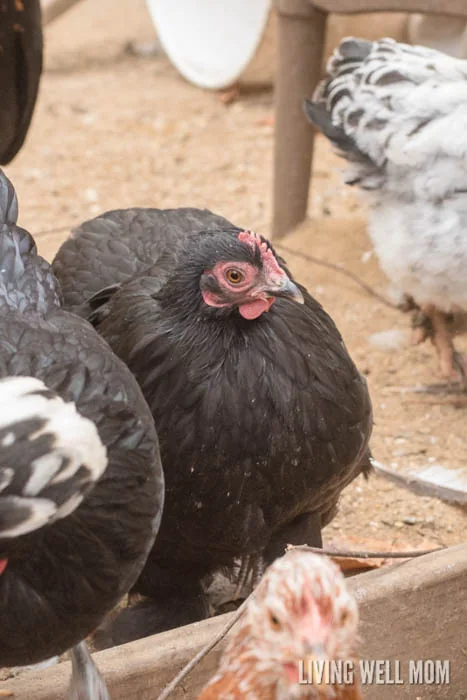
And here is Jack, her cockerel brother. He is also a bantam black cochin.
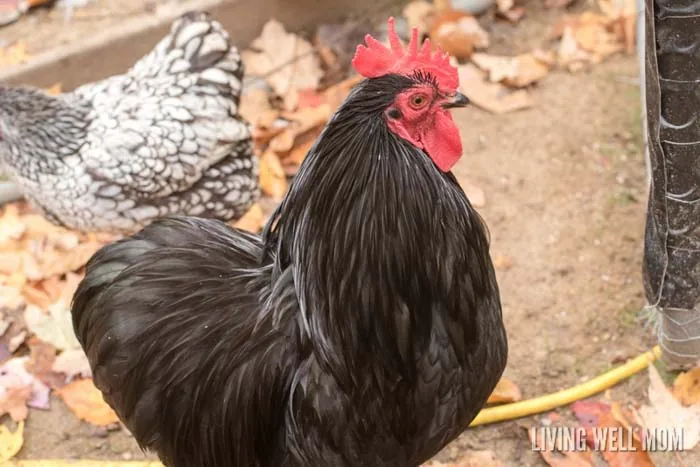
Now, the next time you hear someone talking about pullets, you know they mean young female chickens!
How to sex a chicken
Several methods for identifying a chick’s sex have developed over time, with some being more effective than others at distinguishing between rooster vs hen chicks.
It’s difficult for the average person to determine a young chick’s gender (referred to as sexing).
In most cases, even experienced chicken owners will not be able to tell whether they have cockerels or pullets until the chicks are at least 2-3 months of age. And even that number can often be longer for some breeds like Silkies.
These are two of our Silkie hens with their young chicks.
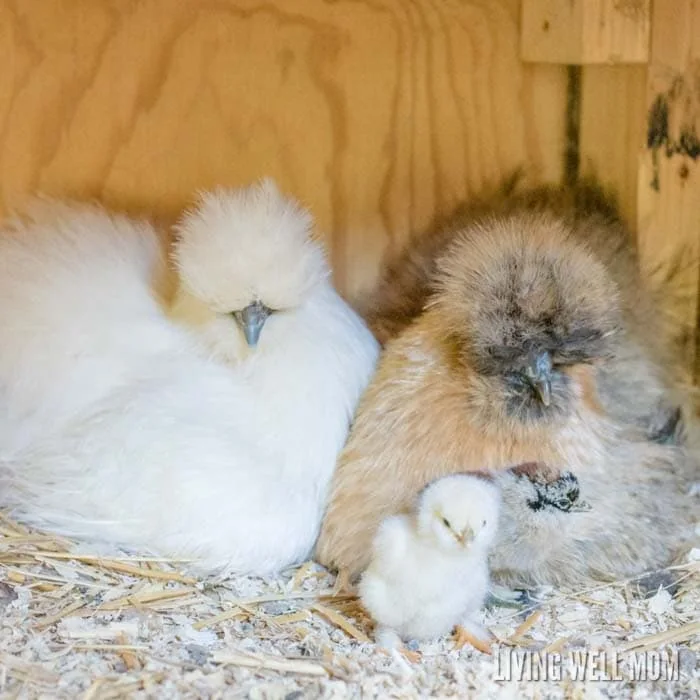
Rooster vs hen vent sexing
The most common form of sexing is called “vent sexing,” but if it’s not done correctly, it could kill a chick. And even then, the odds are about as good as a coin toss when it comes to accuracy with this method unless it is someone very experienced.
This is why the average backyard chicken keeper should not attempt this. I have not and will not, and I highly recommend you don’t either.
In fact, typically, the only places you can buy “vent sexed” chicks are hatcheries, where they have highly trained professionals to do it. Even then, hatcheries are only accurate about 90% of the time.
This means that if you order female chicks from a hatchery or your local feed store (they usually buy from hatcheries, too), you still have a chance of ending up with one cockerel (or more.)

Here is a great article from Backyard Poultry that talks about sexing baby chicks.
Straight run chicks
If you buy chicks from a local chicken breeder, they will likely sell you “straight run” chicks.
Straight run means the gender is unknown, and chicks are not sexed (again, because it’s nearly impossible), and your odds of having boys or girls are usually 50/50.
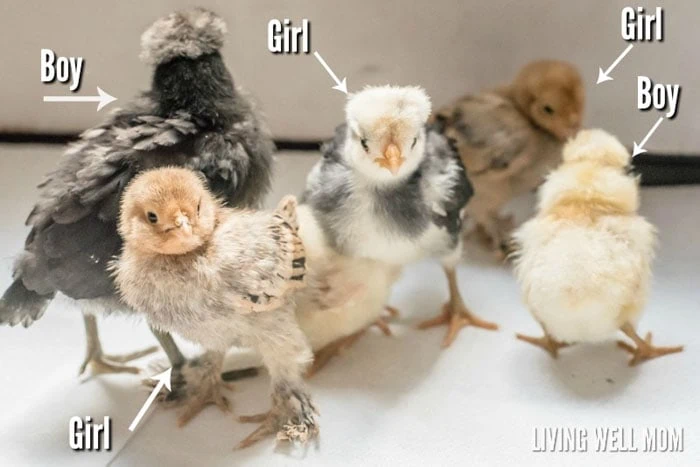
There are some crossbreeds, known as sex links, and a few other chicken breeds where you can tell the gender right away after hatching based on their colors.
You can read more about sex links down below or here. That being said, you cannot tell the gender of day-old chicks in the majority of chicken breeds.
6 Physical characteristics that can help identify pullet or cockerel
We all wait anxiously to see if our chicks are boys or girls. We can guess all we’d like, but as many people who raise chickens like to say, you won’t know for sure until they crow or lay an egg!
That can be anywhere from 12-30 weeks of age. Occasionally, though, you might have a little cockerel who makes himself known by crowing very early. We had a young Silkie start crowing at just 6 weeks of age!
Still, it’s fun to guess the sex of a chick and see if you’re right later.
For older chickens, typically 3-6 months of age, there are a few characteristics you can look for.
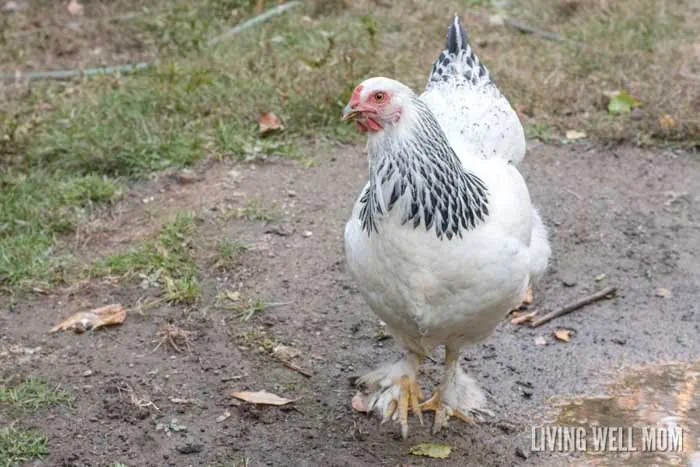
1. Size and color of combs and wattles
A chicken’s comb is the crest-like growth on top of a hen or rooster’s head. As chickens begin to mature, their comb will grow in size and darken in color. A cockerel will usually have a larger and brighter comb than a hen.
It’s the same thing with their wattles (aka the “skin” that hangs down from under the beak or neck). Much like combs, a male chicken will have a brighter and larger wattle than a female.
This is Wolf, our light Brahma cockerel when he was very young. You can see his comb and wattles beginning to get bigger and brighten.

Here’s a photo I took of Wolf today. See how his comb and wattles are bigger now? Wolf is still considered a cockerel because he is 7 months old.
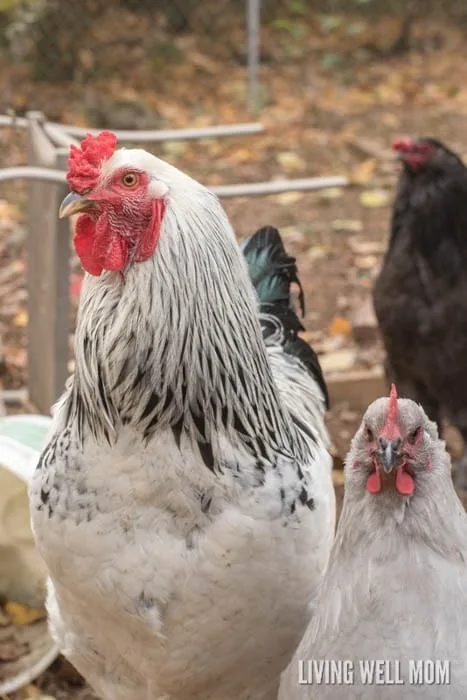
On the other hand, here is “Fireball,” our light Brahma pullet. She is also 7 months old. Do you see the difference?
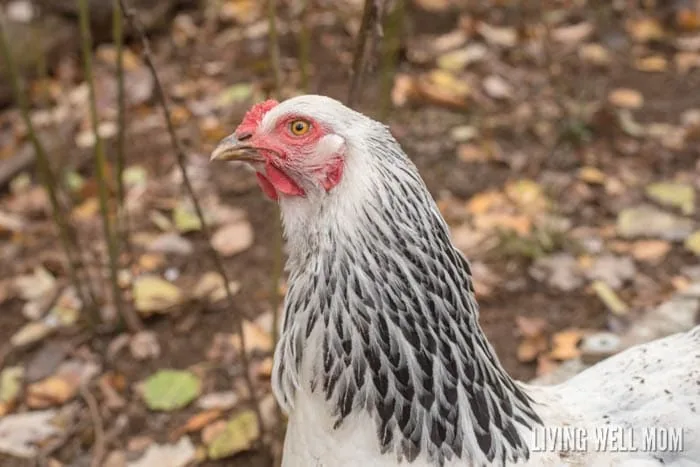
Fireball and Wolf belong to my oldest, Nathan. Their names are from Minecraft. 🙂
Sometimes you will see a young chick begin to develop a larger comb earlier than the others, and this is sometimes (but not always) a clue as to its gender – usually a male.
2. Feather sexing rooster vs hen
Hackle feathers are another word for neck feathers. A hen’s neck or hackle feathers will be round and short when compared to a rooster’s, which are longer and more pointy.
You can see Fireball’s hackle feathers here:
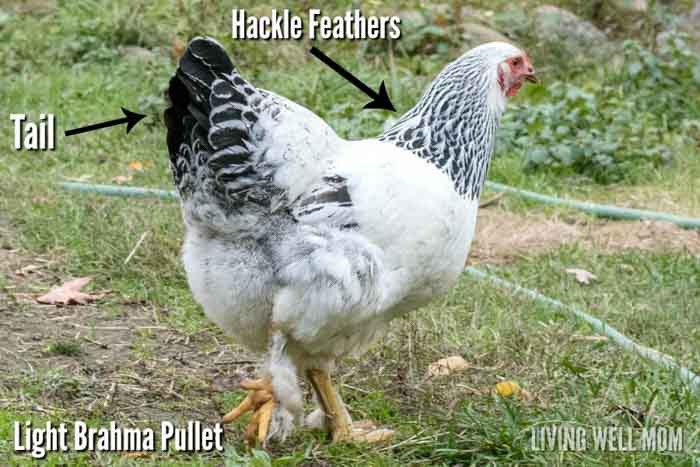
Saddle feathers are only found on boys. These feathers grow on their back down toward their tail. They become fairly obvious once a cockerel is older.
One way to remember the difference between hackle and saddle feathers is to think of a horse saddle that goes on a horse’s back, not the neck.
Lastly, look at a chicken’s tail feathers. A cockerel or rooster’s feathers will be longer, more flowing, and generally showier. Sometimes there will be more colors, such as shiny green feathers.
Here is Wolf again. Notice the differences between him and Fireball.
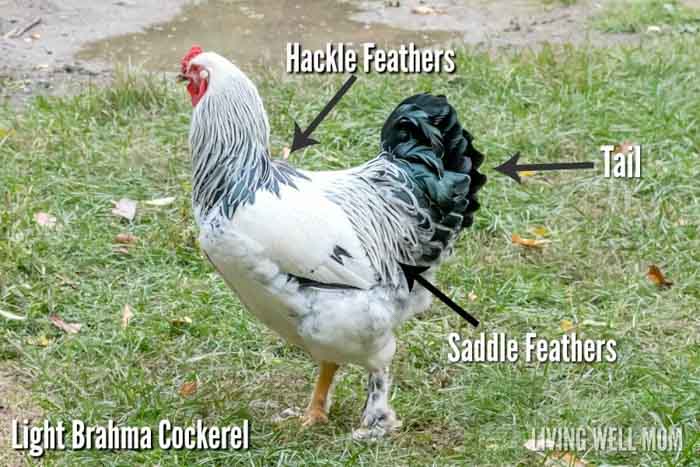
3. Rooster vs hen behavior differences
Roosters are often bolder than hens. You might notice this behavior in small chicks. As they get older, roosters will tend to “challenge” each other with raised hackle feathers.
But this behavior isn’t exclusive to the boys because even the girls “challenge” on occasion! Of course, there are exceptions too. We’ve had shy roosters and braver hens.
4. Posture of hens vs roosters
Cockerels tend to puff out their chest and stand taller than pullets.
This is Smokey, our sweet barnyard mix (that means mixed breed) cockerel:
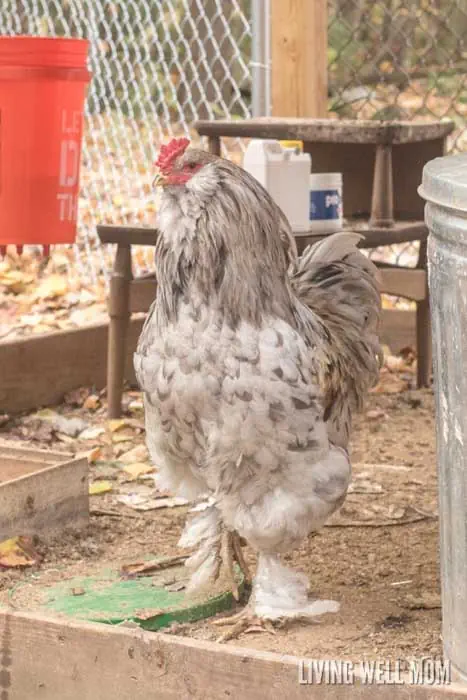
5. Rooster vs hen leg size
Boys will have thicker legs than girls.
For me, this is one of the last things I consider when telling hens and roosters apart, but it is one more characteristic you might notice.
6. Spurs
Some, not all, cockerels will develop spurs on their legs, a bony growth that grows from the inside of their legs. Spurs can be used as a defense and can be dangerous if you have an aggressive rooster.
Luckily, there are ways to safely remove spurs without injuring the roo.
This is Hairy Potter, my son’s Silkie rooster. (Yes, he deliberately spelled it Hairy, not Harry.) Hairy does not have spurs. (Not that you can tell under all his fluff!)
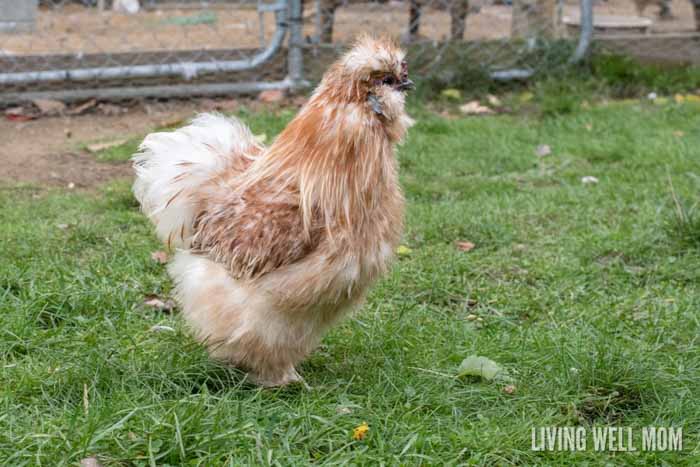
Rooster vs hen FAQs
I know people have tons of questions about distinguishing male chicks from female chicks. Here are a few that I see a lot!
Can chickens lay eggs without mating?
Yes, hens can lay eggs without mating. However, unfertilized eggs will never become chickens. If you want to expand your flock, you’ll need a rooster to mate with your hens.
Is a rooster a cock?
Yes, they are the same thing. Traditionally, “rooster” is the American term, while “cock” is the British term. However, there are some parts of the states (especially in the South) where people use the term cock for roosters.
What is auto-sexing?
Autosexing refers to the ability to determine the sex of newly-hatched chicks based on looking at the color and marking on their down. This is the result of crossbreeding efforts in the UK in the early 1900s. Only certain breeds of chicken are auto-sexing breeds, including Cream Legbars, Barred Plymouth Rocks, and Welsummers, to name a few.
Note: This is a trait that will pass on to future generations of chicks. If you have these types of chickens and breed them, their offspring will also have them.
What are sex link chickens?
Sex links are first-generation chicken hybrids that are visually sexable. If these adult birds breed, however, the visual sexing trait will not pass to the offspring. Examples of sex link breeds include Golden Comet and Black Rocks.
Overall, remember there’s no guaranteed way to tell the difference between rooster vs hen chicks until they are crowing or laying eggs. But these are some fun clues to consider as your chicks grow bigger, and it’s always fun to play the guessing game!
More fun with raising chickens
If you found this rooster vs hen post helpful, be sure to check out these other popular chicken-related posts:
- Will Raising Your Own Chickens Really Save Money On Egg Costs?
- 5 Reasons Raising Chickens Is Perfect For Families
- Our Chicken Coop Tour
- 20+ Reasons You Might Be A Crazy Chicken Lady
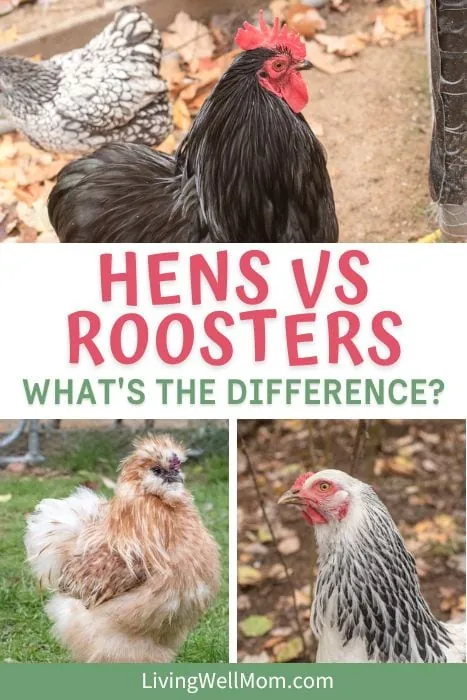
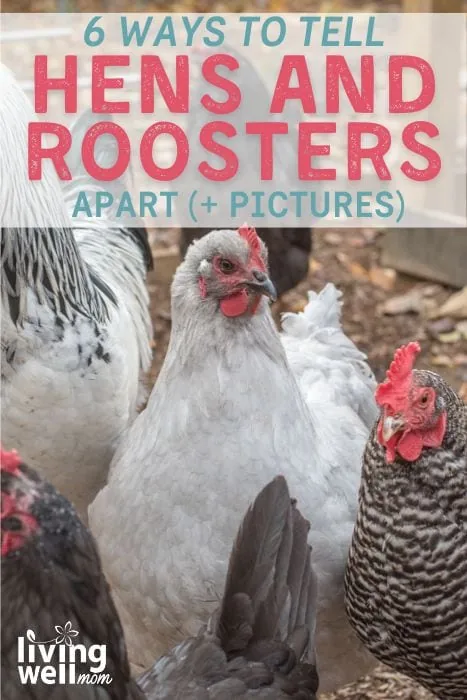
Scarlet Paolicchi says
I loved looking at your chickens. My grandmother always raised chickens and it makes me miss her fondly whenever I see chickens.
Erika says
Chickens are wonderful animals!
Sabeti Farrokh says
Me too, but we have a brown chick which doesn’t know how to crow or walk, it seems that he/she is neither hen nor rooster, we named him or her monster.
Nicole says
Your chickens are so pretty!
Cove says
HI. How old is Wolf in the first photo of him, when he was younger?
Erika says
He was about 3 1/2 months old then.
Dawn Mayhew says
We just got our very first ever batch of chicks! Our HOA does not allow roosters so I am anxious to find out which ones are roosters before I fall in love with them all. On that note, have you heard of rooster collars or anti-crow collars ? Are they humane?
Anastasia says
This was very helpful! My chicks are 8 weeks old and I’m anxious to find out if any or roosters because it’s against city ordinances for us to have any males. Thank you for the post!
Erika says
Fingers crossed you have hens!
James says
Hey Ericka,
Thanks for this, my wife and I have a small 20 acre property in Victoria, Australia. We have chickens and are trying to tell them apart at the moment. I am pretty sure we have four roosters and one hen! Gonna test your theories tomorrow and see if I can better identify them.
Julie says
Your chickens are beautiful! We have several different breeds. Most are hens and as our luck would have it…our rooster is a jersey giant. Is there a way to safely and completely remove spurs? I have 2 small children and I’m so afraid they will get hurt.
Thank you!
Cheryl Jolly says
I’ve been hatching chicks for a few years now and I have noticed that cockerals talk when they eat. I’ve had only one or two pullets do it but for me it’s rare. It doesn’t matter the breed. So next time you’re day old chicks are eating, listen to them!
Ashley Furin says
Great post! Very helpful! I read a few other posts in the search results and yours was the most informative and helpful by a landslide! Thanks so much for sharing your knowledge!
Erika says
You’re welcome, Ashley! Hope your chickens are well. 🙂
Stacy says
I have two silkies I’m still trying to figure out what they are. I want eggs so I’m hoping for a girl(pullet).
I think I have one of each but not 100% sure yet. I bought them from a farm in Ca. I bought ducklings and they sent me my ducklings and chickens. They are black and finally looking pretty . I’ve been reading up on chickens . I have pictures.
Erika says
Silkies are harder to tell apart and you may have to wait until they are around 6 months to know for sure. Yes, it’s a long time! (I have several juvenile silkies at the moment and it’s still TBD on their gender!)
Ashley says
We are having the hardest time sexing our chickens. I’ve read lots of articles, and yours was the most helpful with pictures! But I’m still getting mixed signs. I’m hoping you can help…
Mixed breed, approximately 4-5 months
Comb, growing but still against their head. More like a large bump right now.
Wattle, non existent. Not even seeing some redness, let alone bags.
Feathers (saddle and hackle), longer and thinner than our other chickens (much like hair). But the others are a different breed so I’m trying not to compare.
Spur, nothing yet.
Crowing, one has began to crow. Not every day but definitely happening. When my boyfriend goes out to shush it, it runs and quiets down. The other one in question makes no noise at all.
Behavior, no aggression at all.
Can you help at all? Thanks!
Erika says
The one that crows is almost certainly a rooster. I’m not sure about the others. If you want to email me a picture at erika(at)livingwellmom(dot)com, I can try to guess.
Ashley M Snyder says
I need help sexing my chicken. Is this something you could do via email or do you have a suggestion of where I could take her (or him I supposed).
Erika says
Hi Ashley, no one can 100% guarantee the sex of your young chicken (unless you have a sex link). I would read the tips in this article and give it your best guess than wait and see if you are right. Good luck!
Annette Buggey Hammel says
Hi Erica you sound super knowledgeable in chickens.. I have two 10 week old and two 3 week olds.. I have pics but have no idea how to attach .. my ten week olds are golden spangled Hamburgh and light Brahma which I was told was a Cochin .. and my three week olds are Americanna and buff Orpington. Because my Hamburgh had all these weird rogue feathers at first I thought she was a he.. but now not sure because none of my babies have any wattles to mention of except my buff Orpington that is only 3 weeks old .. Do buff orps show wattles early??
Erika says
Hi Annette, I don’t believe buff orpingtons get their wattles any earlier than any other breed. I have a couple buff hens and their wattles appeared along with other breeds their age. If you want to send me pictures, you can email me at erika@livingwellmom.com. Hope that helps!
Simon says
Hi Erika,
Really interesting piece, and I love the mix of your chickens 🙂
I have 2 Brahma chickens. One black, and one white. I got them originally, so I could have eggs, but I am afraid that your article may have just confirmed that I have 2 roosters. They are such lovely pets, so I’ll definitely keep them, and I am a vegetarian, so there is no chance they will ever end up on somebody’s dinner plate. It’s just a shame I may see no eggs, though.
Thanks again for the piece.
Simon
Netherlands
Erika says
Hi Simon, thanks for stopping by and commenting. It sounds like you have some lucky chickens on your hands and they’ll have a wonderful home with you regardless!
macie says
Thank you! very helpful
Mel says
I have a 6 week old that gets picked on by two other 6 week olds all are different breeds. she will run away from them and hide when she sees either of them come near her is this normal behavior she seems terrified of them
Erika says
Is she smaller than the others? Does she have room to run away?
Maegan says
Thank you for this post. Most other websites don’t post picture or if they do they only post a vague picture of a rooster without a hen comparison shot. Yours actually has diagrams.
Erika says
You’re welcome! 🙂
Holly R Chisholm says
I love your pictures of the Light Brahmas. I have a LB who is about 13 weeks old. She looks a lot like your pullet picture, but this one’s legs are the size of tree trunks!! Is that a tell-tale sign of a cockerel in Light Brahmas?
Erika says
Thicker legs can be a sign of a cockerel but it’s not a sure guarantee. Keep an eye out for other signs – he or she will let you know soon!
Jane Saraph says
Very informative, thank you!
Lacy R Susman says
Great post! Very informative. We have 4 chickens and I think one might be a rooster. Thanks for your help!
Erika says
You’re welcome! 🙂
EFDogs says
Thanks so much that’s Very helpful
Thomas says
Awesome! I love chickens, and the food they make is always appealing to me. Thanks for your sharing
Cindy says
Thank you for this interesting article! I Googled asking if there are white roosters because I live on a lot on a farm and there is what I thought was a white hen but now I think it is a rooster. I did google before and found out that there are some hens that will “cockadoodledoo” but now I think it is a rooster because of the feathers. But I guess I could ask the owner. I love chickens and the roosters are gorgeous. Thank you for sharing your story and pictures!
Erika says
I’m glad I could help, Cindy! Thank you!
amber hodge says
Great article! Very helpful with the photos. Our bantam brahmas weren’t looking too different until recently, when one got a redder face…he crowed this morning. So I do have a question, though….since some breeds of hens get spurs, how can spurs be used for sexing? I know they all have the bumps because it is a part of their bone…but i know certain breeds, like my cream legbars, grow spurs in both sexes…and I’ve heard almost every breed of hen can get them, especially later in life. Will a Cockrell get them earlier? Is that how they may be used in sexing?
Erika says
Hi Amy, yes a cockerel should get spurs earlier and they will be more pronounced, but as you can see with your cream legbars, it’s not a sure-fire way to tell. I would lean more toward the other signs with your legbars in this case. Good luck! Fingers crossed you get more hens than roos! lol
Heidi says
Why are Roosters illegal some places? O.0
Erika says
I’m guessing you can’t have roosters? So sad! 🙁
Connie says
Under your picture of Jack, at the top, there is then pics of chicks and below a group of pictures, on the far right orange and spotted little rooster and hen. They are adorable. I have a hen. I don’t even know what they are called but would love to what they are so I can search for them. Also I had a pair of the same size with different shades of white. The little rooster went missing a few weeks ago, mine always free-range. Two days ago the little hen hatched 8 tiny chicks🐥 .
I would so appreciate hearing back from you. Thank you.
Erika says
Hi Connie, those chickens are mille fleur du’uccles. Both are hens in that picture. They are a super sweet breed! Sorry to hear your rooster went missing. 🙁 Our mille fleur rooster (not in the picture) disappeared a few months ago while free-ranging too – we think a fox got him. 🙁
Lesslie says
This post is helpful. Thanks you for sharing!
Erika says
You’re welcome! 🙂
Muggie says
Thank you for your article, very helpful!
I have 7 hens and about a week ago adopted 2 more from an acquaintance who had complaining neighbors. 🙄 Turns out one of them is a rooster! I heard him crow and I got SO excited! 😍 I was downright giddy! (My husband thinks I’m nuts 🤪) My neighbors are far enough away to not complain. 🤗 I have a mixture of bantams and silkies. There’s one light red in color that I have no clue what she is. She is the friendliest, and until I acquired the rooster, was in charge of the flock. I love watching my chicken TV and am super excited to see how the rooster adds to the mix!
Erika says
Aww that’s great! I love hear chicken stories.
Lisa says
Wow… so useful to me, finally I can identify my roosters and hens when they are younger Thank for this post. Keep sharing!
Esther says
Hi Erika!
This was so useful to me! I absolutely love chickens and have always had them ever since I was born. Unfortunately, where i live, I can’t have roosters which really sucks cause i always have to give them away and some of my roosters were so sweet and I have plenty adorable chicken stories with them.
Right now, I have a bantam (I think) and a light Sussex, they’re both about 3 months old. I’m pretty sure the bantam is a girl, though still very uncertain about the light sussex. She doesn’t act much like a boy, and hardly tries to fight the bantam, but sometimes her comb and wattle look red and makes her look a little like a boy. I was wondering if I could send you a picture of her to see what you think? (Really hope it’s a girl, so sometimes i could be biased when i think she’s a girl).
But then again, her comb and wattle seem about the similar size as the bantam’s. So fingers crossed!
Erika says
Hi Esther, sure you can email me – erika@livingwellmom.com.
Dandre says
My rooster kept on stealing the neighbour’s hens. We only have a night coop against predators so I trained him to picket. Now he roams happily as far as the rope allows and still protects his family.
Erika says
I’ve never heard of training a rooster on a picket rope before – how interesting!
Felipa says
This is so helpful. Your pictures really make it easy to tell whether they are roosters or hens. Thanks for sharing and love your site
Jeanine @ homesteadholland.com says
You’ve got a lovely variety, Erika! We’ve got three Cochin Kriel (Bantam in the Netherlands) chicks and eagerly waiting to see what they are – we all have different bets in! Wish there was a sure way to know since we’re in a suburban neighbourhood and we’ll have to trade in our rooster if we end up having one. Unfortunately, our kids are so attached already, so hoping they’re all ladies!
Erika says
I hope they are girls too! It’s so hard to have to say good-bye to roosters.
Rebecca says
How can you tell if they are males or females so well? Have you been practicing a lot with all your chickens and roosters? Please answer me soon. Thank you.
shelby says
thank you for this accessible read!
Kenny says
Thank you for sharing the post! I like it a lot!
Bonnie Ecker says
Can I have a dominant hen? All 6 almost the end of 5 mo old. It’s larger than all others and is very alert to its surroundings and people that aren’t me (attacked my 2 girl chicken-sitters, putting a gash in the cheek of one gal). Feathers on all 6 birds look the same. No crowing. Just starting to get eggs, but I don’t know which are laying.
Erika says
Yes, it’s possible to have a dominant hen, but usually those kind of characteristics mean a rooster. The fact that it’s larger than the others is another sign you may have a roo on your hands. How do the comb and wattles appear?
Rosemary says
Hi Erika, I love Smokey your mixed breed rooster . Can I ask what 2 cross breeds he is ? You have beautiful chickens . I enjoyed your column too. Thank you …… Rose
Erika says
Thanks, Rose! He was (sadly he passed away last year) cochin and Easter egger. I miss him so much – he was one of the best roosters I’ve ever had.
Flyi Da Cool Guy says
Nice read. I enjoyed learning about the differences. If I had the facilities Id love to have a rooster as a pet.
Alicia R King says
Thank you so mulch, Erika! I really appreciate you sharing your knowledge with us! I have had chickens for 3 years now, but we are raising our first ones from babies this year. Once I read what was said here, I went and looked and sure enough! I found we only have 1 rooster out of 32.
What do you do when you want only hens and have a roo pop up? I don’t want fertilized eggs. We keep our ladies in a large pen and are fixin to build a 2nd one to help with the hens when they are all laying. Currently, we only have one pen and I have never let my chickens out to free range, as we have large wildlife birds of prey around. He is only about 8 weeks old at this point.
Erika says
Hi Alicia, I’m glad this helped! So you don’t want a rooster at all? Your best option is try to find him a new home, but that can be tricky as there are usually an over abundance of roosters. (Be careful who you rehome to because there are some unkind places to put it nicely. 🙁 )